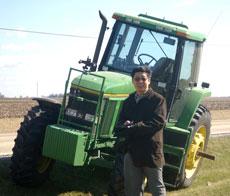Researchers build intelligent tractors

Professor Qin Zhang takes a tractor containing a new technology he is developing called Active Rollover Prevention out for spin on Tuesday afternoon. The technology allows the tractor to calculate distances and angles to approach the ground. Cyndi Loza
March 17, 2006
Research at the University is being used to create intelligent tractors that can see the terrain ahead to navigate ditches and apply chemicals at variable rates.
“With today’s farm, there are new challenges,” said Qin Zhang, a University professor of agricultural and biological engineering.
Zhang and researchers are developing technology that aims to increase safety and precision on farms.
Compared with the farms of our great-grandfathers, today’s farms and farming equipment are larger, making it difficult to apply appropriate amounts of chemicals when crop health varies, Zhang said.
To combat this problem, Zhang and researchers have developed a system called Sensor-based Variable Rate Application. In this system, a camera attached to the front of the tractor captures pictures of individual crops. A computer-integrated system detects the health of each plant as the tractor moves. Levels of fertilizer or other chemicals are adjusted to meet the needs of each crop.
Get The Daily Illini in your inbox!
Safety is also an issue when farmers are driving tractors during peak times and are required to concentrate for long hours, Zhang said.
More than 200 tractor-related deaths occur per year in the U.S., according to an article published in American Journal of Preventative Medicine in 2000. More than half of these deaths are caused by tractor rollovers. Fatalities are prevented in tractors equipped with rollover protection, which is a heavy metal frame that surrounds the cab and prevents the operator from getting crushed during a fall.
“The problem with this structure is that it does not prevent the tractor from rolling over,” Zhang said.
He said the frame in the tractor serves a similar function as an airbag in a car.
Zhang is also developing a system called Active Roll-Over Prevention, which will be ready for use in demonstration models in about five years.
The system also uses camera technology. Information from two cameras is integrated in a computer that calculates the incline of the terrain that lies ahead of a moving tractor. The computer makes a decision about whether the tractor can safely navigate the terrain. If the incline is too steep, the tractor will stop or plan a different approach to the incline, Zhang said.
Scott Bidner, president of the Champaign County Farm Bureau, has been farming land near Champaign for about 10 years. He said some of the new technologies being developed, that may replace farmers, would probably not be useful or cost-effective for mid-sized farms.
Bidner’s farm is about 1000 acres and uses some new technology such as a satellite for grain-market information and digital cameras. Bidner has three tractors, the newest made in 1997. The others were made in 1986 and 1982 and all are in good condition, he said.
“I would like to see research, guided first and foremost by not whether or not we can improve production, because we know how to grow corn and soybeans, but whether or not that research can be used to help family-sized farms,” Bidner said.
Chris Hausman farms 1300 acres full-time in Pesotum, Ill.
Hausman said that farming technology has changed tremendously, based on his experience being raised on a farm and farming professionally for 15 years.
“Our equipment size continues to increase, and we’re able to accomplish more with basically the same workforce,” he said.
Hausman said it would be helpful to have equipment that decreases the focus required of a farmer working long hours.
“I think anytime fatigue sets in, you’re always more prone to accidents,” he said.
It is difficult to justify cost of some of the new technologies on a mid-size farm, Hausman said.
The goal of Zhang’s research is to integrate the different technological advances he has worked on and make them invisible to operators.
“If like a human, (the tractor) has an eye, hand and brain, it can release the farmer from intensive labor,” Zhang said.
Creating all the senses and intelligence of a farmer is a distant goal, he said.
“No matter how intelligent we can make a tractor in the foreseeable future, there is still no way we can replace a human,” Zhang said.






